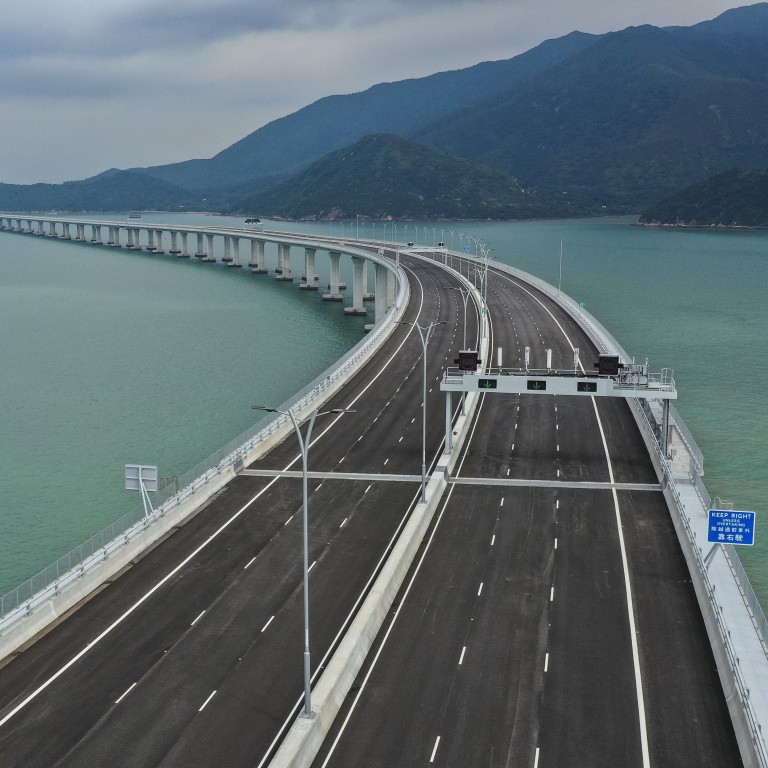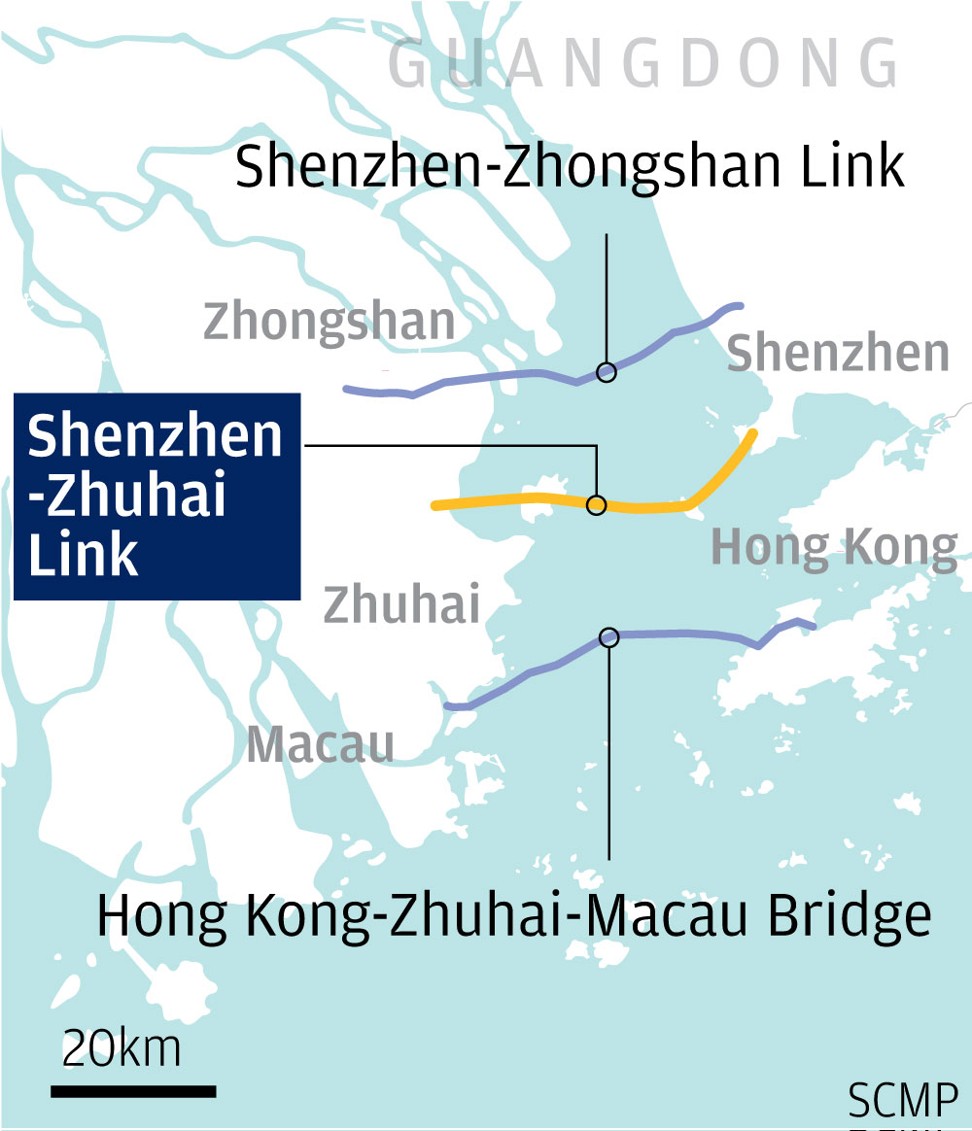
Zhuhai’s proposal for new bridge linking it with Shenzhen means Hong Kong should rethink its relationship with mainland neighbours, lawmaker says
- Mayor of mainland city announces plan to build 46.5km crossing that would include a high-speed rail link
- Shenzhen economist says lack of traffic on Hong Kong-Zhuhai-Macau Bridge shows project is a failure
A recently unveiled plan by Zhuhai’s top officials to build a bridge to connect the city with Shenzhen has raised concerns of reignited rivalry with Hong Kong and worries that such a link could hurt usage of the Hong Kong-Zhuhai-Macau Bridge.
The proposal calls for a crossing that will slash travelling time between the two cities to just 30 minutes – down from two hours now – and it would have a high-speed railway line as well.
Zhuhai mayor Yao Yisheng first revealed to the media the city’s ambitions at the end of the annual session of Guangdong’s legislature last month. He said Zhuhai hoped to start planning the bridge as soon as possible in comments that went largely unnoticed then, just before the Lunar New Year holiday period began.
Ideally, travel between the two cities would be via high-speed trains able to go at least 200km/h, said Yao, and Guo Yonghang, the city’s Communist Party chief.
Yao said connecting Shenzhen, Zhuhai and Zhongshan by high-speed rail would be a boost to the coastal economic zone around the Pearl River estuary.
Zhuhai is 155km from Shenzhen. Hongkongers can travel to Shenzhen in less than 20 minutes via the high-speed rail link that opened in September, and can get to Zhuhai in 1½ hours via the Hong Kong-Zhuhai-Macau Bridge which opened in October.
Zhuhai’s proposal is for a 46.5km bridge that would go across the Pearl River estuary to Qianhai, a booming financial hub on the west coast of Shenzhen.
It will be located midway between a bridge being built to connect Shenzhen and Zhongshan to its north, and scheduled to open in 2024, and the Hong Kong-Zhuhai-Macau Bridge to its south.
Some commentators see the Zhuhai proposal as a way to pacify Shenzhen, which was left out of the Hong Kong-Zhuhai-Macau Bridge project.
Shenzhen had lobbied hard to be included in that project, suggesting a double-Y-shaped bridge with one extension connected to it, but the idea was vetoed by mainland authorities.
Zhuhai party chief Guo dismissed the suggestion that the new proposal was meant to make it up to Shenzhen, saying the idea for a Zhuhai-Shenzhen bridge had been in place a long time.
“At first the idea was for a bridge for vehicles only,” he said. “But now, given the central government’s demand for faster integration of the Pearl River Delta, a high-speed railway is needed.”
Some experts on the mainland and in Hong Kong fear the new link would take traffic away from the Hong Kong-Zhuhai-Macau Bridge, which is already being used less than officials anticipated. But other academics and logistics industry veterans believe there is nothing to worry about.
The 55km Hong Kong-Zhuhai-Macau Bridge cost hundreds of billions of dollars and took nine years to build, but as of January 15, daily traffic volume had not met the Hong Kong government’s projected 14,000 vehicles a day.
Beijing approves blueprint for Greater Bay Area to rival Silicon Valley
Shenzhen-based economist Qu Jian, vice-president of the China Development Institute think tank, supports the idea of a Zhuhai-Shenzhen bridge.
“The development of the bay area requires more efficient flow of talent and a high-speed rail network covering the whole Pearl River Delta,” he said.
He said the low traffic flow on the Hong Kong-Zhuhai-Macau Bridge showed it was a failure and a big lesson for cities in the Greater Bay Area.
Qu said the low usage was not because of a lack of demand but a major flaw in the design – the failure to include a link to Shenzhen.
He expected the proposed Zhuhai-Shenzhen bridge and railway project would inevitably take away some traffic from the Hong Kong-Zhuhai-Macau Bridge.
But Zhuhai party chief Guo said that even if the bridge had included Shenzhen, another link between Zhuhai and Shenzhen would have been necessary.
Why the Greater Bay Area hard sell won’t work on young Hongkongers
Mao Yanhua, a regional economy expert at Guangzhou’s Sun Yat-sen University, said Hong Kong need not worry unnecessarily about the proposed link, which he felt was not a priority.
“The Hong Kong-Zhuhai-Macau Bridge is a project promoting the ‘one country, two systems’ principle and therefore firmly supported by the central government,” he said.
If Zhuhai and Shenzhen hoped to get Beijing’s approval for their plan, he added, the municipal governments would have to convince the central authorities the project would be financially sustainable, environmentally friendly, and not redundant.
Public transport industry veterans in Hong Kong said they were not worried by the proposal as the impact on Hong Kong would be limited.
Lam Hoi-tat, president of the Hong Kong Container Tractor Owner Association, said freight moving between Hong Kong and the west bank of the Pearl River Delta accounted for only 5 per cent of Hong Kong’s total freight.
He said freight vehicles using the Hong Kong-Zhuhai-Macau Bridge were only allowed to go between Hong Kong and the mainland, but not Macau. He expected usage of the bridge to improve when freight could go to Macau as well.
Lam also believed that the development of the Greater Bay Area would lead to more relaxation of licence regulations and customs checks, which would also boost traffic on the bridge.
Liberal Party lawmaker Frankie Yick Chi-ming, who represents the transport sector in the legislature, felt it was too early to assess any impact the proposed Zhuhai-Shenzhen bridge might have.
Much would depend on how much commuters had to pay to take the bridge from Zhuhai to Shenzhen, and then to Hong Kong. Some might well prefer to use the cross-border bridge from Zhuhai to Hong Kong, he said.
Yick believes that even with a new Shenzhen-Zhuhai link, visitors would choose to take the high-speed rail to Shenzhen and Hong Kong, instead of the cross-border bridge.
But Civic Party lawmaker Jeremy Tam Man-ho, vice-chairman of the Legislative Council’s Panel on Transport, said Zhuhai’s proposal smacked of intra-regional competition, and showed that Hong Kong needed to rethink its relationship with cities in the Greater Bay Area.
He said: “It’s not the first time that after Hong Kong makes a great investment for connectivity, other cities in the area roll out a separate plan that can undermine Hong Kong’s benefits.”


